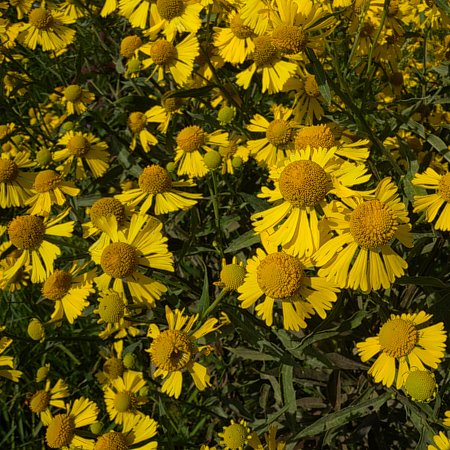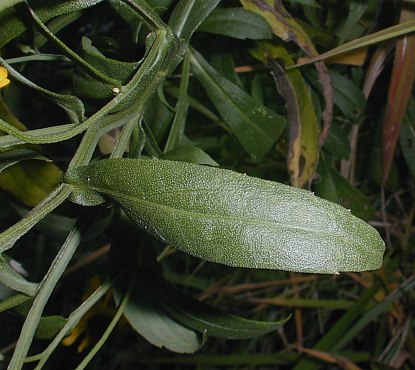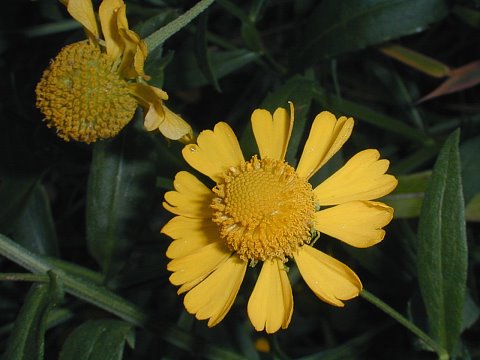Description: This perennial plant is 3-5' tall, branching sparingly to occasionally. It has greenish stems that are angular and winged. The alternate leaves are up to 5" long and 1½" across; they are lanceolate-oblong to elliptic-oblong in shape and slightly serrated along their margins. The leaves are either sessile or their bases clasp the stems. Upper stems terminate in flowerheads spanning about 1½-2" across; they are usually produced in abundance. Each flowerhead has a slightly flattened to globoid head of yellow disk florets that is surrounded by yellow ray florets. The petaloid rays of the latter florets are narrowly triangular in shape (broader at their tips than at their bases). The tips of these unusual rays are doubly notched, creating an interesting effect. The tubular corollas of the tiny disk florets are less than 1/8" across. The blooming period occurs during the autumn for 1-2 months. Afterwards, the florets are replaced by achenes that lack tufts of hair; they are distributed in part by water. The root system is shallow and fibrous.

Cultivation:
The
preference is full to partial sun, wet to moist conditions,
and soil containing loam or silt that is relatively high in
organic material. Common Sneezeweed can appear sloppy and unkempt,
particularly if it is allowed to dry out.
Range & Habitat:
The native Common Sneezeweed occurs throughout Illinois, where it is
quite common in the central and northern sections of the state (see Distribution
Map). In southern Illinois, this plant is less
common or absent. Habitats include moist black soil prairies, moist
meadows in wooded areas, moist meadows along rivers, moist open
woodlands, soggy thickets, fens, marshes, poorly drained pastures and
abandoned fields, low areas along streams and ponds, and ditches. It is
not uncommon to find this plant growing within a few feet of
water in both disturbed areas and higher quality habitats. Recovery
from fire is poor.

Faunal Associations: Probably the most common visitors to the flowers are long-tongued bees, including honeybees, bumblebees, long-horned bees (Melissodes spp.), cuckoo bees (Coelioxys spp., Triepeolus spp.), and leaf-cutting bees (Megachile spp.). Other visitors include Halictid bees, Sphecid wasps, Vespid wasps, Syrphid flies, butterflies, and beetles. Most of these insects suck nectar, although some bees also collect pollen and some beetles feed on the pollen. The aphids Aphis vernoniae and Uroleucon tardae suck plant juices from Common Sneezeweed, while the caterpillars of Papaipema rigida (Rigid Sunflower Borer Moth) bore through its stems and feed on the pith. Mammalian herbivores usually don't feed on this plant because its foliage is toxic and bitter. There have been reports of severe poisoning for livestock that have consumed this plant, producing such symptoms as congestion of the kidneys and liver, formation of necrotic areas in the lungs, and irritation of the digestive tract. Not surprisingly, Common Sneezeweed is considered an 'increaser' in grazed meadows.

Photographic
Location:
The photographs were taken near a drainage ditch at Judge Webber Park
in Urbana, Illinois, and in a wetland area of Weaver Park of the same
city.
Comments:
Notwithstanding its common name, this plant doesn't cause sneezing or
hay fever during the autumn – its pollen is distributed by insects,
rather than the wind. Common Sneezeweed blooms quite late in the year,
providing some fall color when other plants have finished blooming. A
similar species, Helenium
flexuosum (Purple-Headed Sneezeweed), differs from Common
Sneezeweed by having disk florets that are purple, rather than yellow,
and its foliage is more soft-hairy. This latter species is native to
southern Illinois.